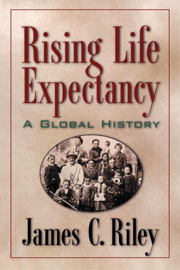Book contents
- Frontmatter
- Dedication
- Contents
- List of Figures, Maps, and Tables
- Preface and Acknowledgments
- Introduction: A Global Revolution in Life Expectancy
- 1 A Brief Overview of the Health Transition
- 2 Public Health
- 3 Medicine
- 4 Wealth, Income, and Economic Development
- 5 Famine, Malnutrition, and Diet
- 6 Households and Individuals
- 7 Literacy and Education
- Conclusion
- Index
Introduction: A Global Revolution in Life Expectancy
Published online by Cambridge University Press: 05 February 2015
- Frontmatter
- Dedication
- Contents
- List of Figures, Maps, and Tables
- Preface and Acknowledgments
- Introduction: A Global Revolution in Life Expectancy
- 1 A Brief Overview of the Health Transition
- 2 Public Health
- 3 Medicine
- 4 Wealth, Income, and Economic Development
- 5 Famine, Malnutrition, and Diet
- 6 Households and Individuals
- 7 Literacy and Education
- Conclusion
- Index
Summary
At the end of the twentieth century everyone could not expect to live an extended life, but humankind had moved closer to that goal than ever before. In 1800, with nearly one billion people alive, life expectancy at birth did not surpass thirty years. By 2000, with more than six billion people alive, life expectancy reached nearly sixty-seven years amidst a continuing rise. This is the crowning achievement of the modern era, surpassing wealth, military power, and political stability in import. Mindful of the effects of declining fertility and optimistic about the future course of survivorship, U.N. demographers project that the global average for males and females will rise from sixty-seven years at the end of the twentieth century to seventy-six years in the middle of the twenty-first century.
This dramatic change is called the “health transition,” in which humankind acquired an expectation of living to be old. These longer lives contributed to population growth, adding people who in earlier periods died at younger ages. Because death rates at ages above sixty-five did not decline until late in the health transition, these longer lives initially filled the ranks of every population with people living in their most economically productive years, 15–64. Prior to the health transition more than half of all people died before reaching adulthood. In some countries and regions more than half died before they reached age ten.
- Type
- Chapter
- Information
- Rising Life ExpectancyA Global History, pp. 1 - 31Publisher: Cambridge University PressPrint publication year: 2001



